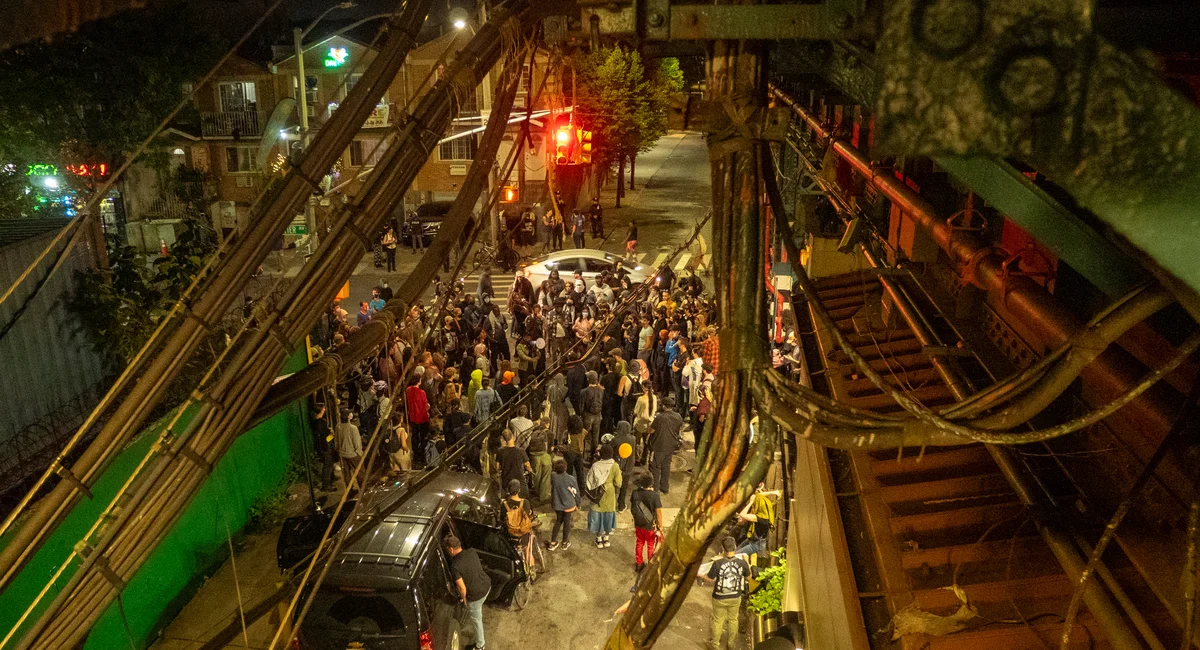Making an (online) scene

Weft for dead
Arachne is cooking with gas. Haven't missed a deadline yet!
This week's piece is the one I am proudest to share so far. I could probably write ten thousand words on this topic, and I probably will someday, but for now here's around 1,500.
Let's go.
In his book How Music Works, David Byrne writes a chapter called "How to Make a Scene." In this chapter, Byrne reflects on the New York City music scene of the 1970s and 1980s and the many factors that made it a fertile landscape for artists such as himself, Patti Smith, and the Ramones.
Here are a few characteristics that Byrne outlines:
Venues
Byrne's observations about venues break down into a few key concepts. First, there must be a variety of venues, with sizes ranging from small to large and vibes ranging from DIY to formal. Think grungy basements AND glitzy proscenium theaters. Think a coffee shop that closes at 4pm and a bar that closes at 4am.
Costs
The costs to access these venues must be kept low. For venue owners, rents and property costs should be low. For the artists, there must not be a "pay-to-play" structure in place, the common practice of artists having to pay fees to perform or show their work. For audiences, there must not be exorbitant cover charges or overhead costs to participate in the scene.
Healthy urbanization
Finally, and in my opinion most importantly, localities must engage in healthy urbanization to promote an arts scene. While Byrne specifically cites affordable housing and anti-gentrification policy, I would add excellent public transit, public funding for the arts, and access to child/pet care.
For many of you reading this, you may be thinking Well, wouldn't that be fantastic! If you live in Chicago or New York, for example, you have experienced a widening gap of wealth inequality, the destruction of mid-tier arts spaces, and dramatic increases to the cost of living.
While the New York Times reports here that Chicago lost at least half a dozen store-front theaters as a result of the pandemic, anecdotal evidence suggests it is far, far more. On top of that, institutions like the beloved Lookinglass Theater have dramatically scaled back production offerings. In New York, even prior to the pandemic, small local performance spaces in Midtown and beyond have faced devastation. Last year, the Public Theatre, the nation's most famous non-profit theatre organization, notable for first staging Hamilton, running Shakespeare in the Park, and offering unparalleled artistic development opportunities, cut 19% of its full time staff. Right here in my current home of New Haven, the storied Long Wharf Theatre has had to exit its longtime home on its namesake Long Wharf.
But the greater tragedy, in my opinion, lies in the mid and lower tier spaces that have disappeared, the ones that do not get write ups in the nation's paper of record. Places in Chicago like Emerald City Theatre or The House Theatre. And these are just theatre spaces.
According to a report done by the office of the New York State Comptroller, Thomas DiNapoli, average housing expenditures in New York City grew 68.4% in the time between 2011-2012 and 2021-2022. Consider this alongside New York's unequal bounce back from the pandemic, as outlined in this article from the Times.
Issues cited in this article include the stagnation of the minimum wage, rising inflation, and the limits of available jobs to meaningfully build wealth.
While I'm sorry to keep harping on New York, there are even more government and local failings that show echoes throughout the country, making the development of an arts scene so difficult. The combination of the embarrassing Adams mayoral administration and the cowardly Hochul gubernatorial administration have not only kneecapped public transit in the city, but made attempting to engage with it cartoonishly hostile.

As cities and towns have spent decades destroying public life, diverting funds for parks and transit and education and the arts toward militarizing combative police forces and putting up code-violating towers for foreign governments, people have moved their attention online.
If online is where the people are, can we take Byrne's tenets of a scene and learn from our civic mistakes and somehow, maybe, possibly create an arts scene online?
Venues
As I see it, there are a few venues online for displaying and fostering engagement with ones art. At the very top we have mass social media like Instagram, TikTok, Twitter, YouTube, or Reddit. These are places with algorithms that function in service of advertisers primarily and with such massive user bases that it can be difficult to target an audience how you might in a local arts scene. Below this, we have more niche platforms like Archive of Our Own, DeviantArt, and Goodreads. Often in these cases the user generated work is aggregated and segmented not by the community or artist from which it derives, but by the content of the work or the art on which it is commenting. On a rung below these I would put things like Substack, Twitch, and OnlyFans, where individual creative workers build and maintain their own communities.
While there are "real world" analogs for these spaces, like open mic nights, poetry jams, raves, and the like, nothing can compete with the scale that these internet offerings provide. Additionally, these real world venues create opportunities for events and happenings in ways that the online experience cannot. Whether you are a worker or an audience member, you gain a sense of presence and community when you are physically in a space with other people engaging with the same work. Your dollar goes farther in the local economy, as you may be going to dinner with friends before attending some event, or buying a drink at the bar, or buying locally made goods.
How, then, can online experiences give people a sense of presence, community, and the "you had to be there" effect? I don't know. I think artists can form more collectives and utilize online tools like the ones mentioned above to create community. I think artists can be more limited in when and where they share and promote their work. Perhaps it'll take being owner/operators of their own platforms for distribution for online arts communities to develop. We are seeing this increasingly in journalism, where sites like Semafor, Defector, and 404 Media have sprung up as collectively owned outlets. What might this model look like for theatre makers? Musicians? Comedians? Writers? Poets? Painters? Graffiti artists? Dancers? DJs? Pastry chefs?
Costs
The cost to access creative work online has never been more fractured, which is both a good thing and a bad thing. Just for example, I am paying money to people on Substack and Patreon, paying for streaming, paying for creative software, and more. While it's good to have more players in the market competing for dollars, it is bad when consumers grow fatigued of subscriptions and have come to expect so much work for free (thanks to Facebook/Twitter/YouTube, etc).
Again, I return to theatre. A common business model for mid-to-large non- and for-profit theaters around the US is to have the majority of revenue come from subscribers and corporate sponsors while offering one off purchasing options like single show tickets, merchandise, and concessions. At the lower tiers, companies may be applying for grants, obtaining sponsorships, rounding up a few donors, as well as selling tickets, merch, and concessions.
How might this model translate to online creative work? Again, I return to creator autonomy over the distribution of their work. Take the case of the streaming service Nebula for example.
While the creators involved in this platform were able to amass audiences on YouTube and sustain them, it was becoming clear that in order to achieve a more sustainable business, one that is free of YouTube's shifting algorithm and advertiser policy, they needed to create their own platform.
In order to justify the cost of access, creative workers will need to think like storefront theatre operators. Not only are you generating the work that goes on the stage, but you are also building the stage.
Healthy Urbanization
Obviously online we don't have to deal with problems like car-centric infrastructure or the militarization of the police in the name of so-called public safety (mostly!). But there are a few things we can do to ensure ease of access, ease of distribution, and ease of monetization for online creative workers.
While the Biden administration has made more leaps in the direction of ensuring broadband internet access for all Americans, we still fall pretty short relative to other nations. We must further ensure that everyone, on every device, can easily stream media and interact with other users in real time.
We must continue to focus on net neutrality where no one company can control the rates at which you engage with online content. It is uncompetitive and monopolistic for a company like Comcast to prioritize NBCUniversal content over other brands and small creators.
We must change our existing copyright laws that massively privilege enormous, historic institutions like Disney. It should be far easier for online generators of work to formally copyright and retain ownership of their work, and should not require having a team of lawyers on retainer.
As the material world has grown increasingly hostile to arts scene development, people have turned online to engage with peers, see what's new, and participate in collective experiences. But despite the many ways the internet has increased scale and reach for developing artists, it still harbors unfavorable conditions for the kind of scene-making, identity forming, rich ecosystem that David Byrne wrote about. There is no online CBGB, but hopefully artists can collectively act to build their stage and exhibit their work from it. I am not only hopeful for this future, but eager to be a part of it.
Thanks again for reading Arachne. Please share with your friends and let me know what you think! I would love to hear from you.
Also! Announcements coming soon for my live session, so make sure you sign up here:








